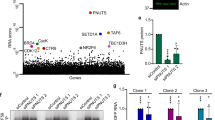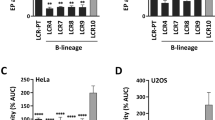Abstract
Enhancers stimulate transcription of several eukaryotic genes (for review see ref. 1). While some enhancers, like that of simian virus 40 (SV40), are active in a wide range of cell types, others are more cell-specific1. For example, the polyoma virus (Py) enhancer is not active in undifferentiated embryonal carcinoma (EC) cells, such as F9 cells, while it is active in differentiated cells2,3. In contrast, the SV40 enhancer is active in both undifferentiated and differentiated EC cells4. One possible explanation for this difference is that the two viral enhancers interact with different positively or negatively acting transcription factors, a notion supported by in vitro experiments showing that the Py enhancer interacts with proteins that do not bind to the SV40 enhancer5,6. Some viral7,8 and cellular9 enhancers, including the Py and SV40 enhancers, can be negatively regulated by the products of the E1A transcription unit of adenovirus-2. As it has been postulated that undifferentiated F9 cells contain an E1A-like activity10, it is possible that the latter is responsible for the lack of activity of the Py enhancer in these cells. We show here that the E1A products do not repress a point mutant of the Py enhancer (Py ECF9.1; ref. 11 and references therein) that is active in undifferentiated F9 cells3. This result is consistent with the idea that undifferentiated F9 cells contain a cellular represser that blocks the Py enhancer and that this represser has the same target sequence as the E1A proteins.
Similar content being viewed by others
References
Serfling, E., Jasin, M. & Schaffner, W. Trends Genet. 1, 224–230 (1985).
Linney, E. & Donerly, S. Cell 35, 693–699 (1983).
Herbomel, P., Bourachot, B. & Yaniv, M. Cell 39, 653–662 (1984).
Sassone-Corsi, P., Duboule, D. & Chambon, P. Cold Spring Harb. Symp. quant. Biol. 50, 747–752 (1985).
Sassone-Corsi, P., Wildeman, A. & Chambon, P. Nature 313, 458–463 (1985).
Piette, J., Kryske, M. H. & Yaniv, M. EMBO J. 4, 2675–2685 (1985).
Borrelli, E., Hen, R. & Chambon, P. Nature 312, 608–612 (1984).
Velcich, A. & Ziff, E. Cell 40, 705–716 (1985).
Hen, R., Borrelli, E. & Chambon, P. Science 230, 1391–1394 (1985).
Imperiale, M. J., Kao, H. T., Feldman, L. T., Nevins, J. R. & Strickland, S. Molec. cell. Biol. 4, 867–874 (1984).
Melin, F. et al. EMBO J. 4, 1799–1803 (1985).
Leff, T. et al. Proc. natn. Acad. Sci. U.S.A. 81, 4183–4185 (1984).
Borrelli, E., Hen, R., Wasylyk, C., Wasylyk, B. & Chambon, P. Proc. natn. Acad. Sci. U.S.A. (in the press).
Gorman, C. M., Rigby, P. W. J. & Lane, D. P. Cell 42, 519–526 (1985).
Sassone-Corsi, P., Fromental, C. & Chambon, P. Nucleic Acids Res. (submitted).
Kao, H. T., Capasso, O., Heintz, N. & Nevins, J. R. Molec. cell. Biol. 5, 628–633 (1985).
Van Ooyen, A. Van den Berg, J., Mantei, N. & Weissman, C. Science 206, 337–344 (1979).
Zenke, M. et al. EMBO J. 5, 387–397 (1986).
De Villiers, J. & Schaffner, W. Nucleic Acids Res. 9, 6251–6264 (1981).
Blochlinger, K. & Diggelmann, H. Molec. cell. Biol. 4, 2929–2931 (1984).
Matrisian, L., Rautmann, G., Magun, B. E. & Breathnach, R. Nucleic Acids Res. 13, 711–726 (1985).
Hen, R., Sassone-Corsi, P., Corden, J., Gaub, M. P. & Chambon, P. Proc. natn. Acad. Sci. U.S.A. 79, 7132–7136 (1982).
Author information
Authors and Affiliations
Rights and permissions
About this article
Cite this article
Hen, R., Borrelli, E., Fromental, C. et al. A mutated polyoma virus enhancer which is active in undifferentiated embryonal carcinoma cells is not repressed by adenovirus-2 E1A products. Nature 321, 249–251 (1986). https://doi.org/10.1038/321249a0
Received:
Accepted:
Issue Date:
DOI: https://doi.org/10.1038/321249a0
- Springer Nature Limited
This article is cited by
-
A functionally inactive p53 protein interatocarcinoma cells is activated by either DNA damage or cellular differentiation
Nature Medicine (1996)
-
A point mutation in the last intron responsible for increased expression and transforming activity of the c-Ha-ras oncogene
Nature (1988)
-
Adenovirus E1A products suppress myogenic differentiation and inhibit transcription from muscle-specific promoters
Nature (1988)
-
Gene expression: Negative regulation of enhancers
Nature (1986)





